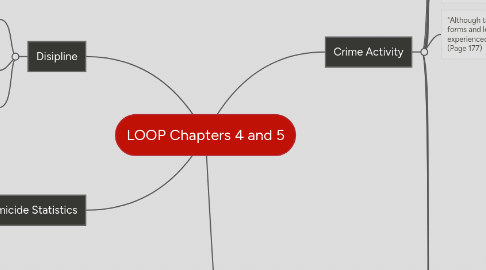
1. Disipline
1.1. Gloria's strategies
1.1.1. Burnt Alexandro's hand on stove
1.1.1.1. Found out that he stole money which was put aside for a wedding gift
1.1.2. Emilo stole money
1.1.2.1. Had to get a job in order to pay Gloria back
1.2. Gloria's Ultimate Goal
1.2.1. To punish them through harsh physical punishment and harsh words
1.3. This chapter (Chapter 5) illustrates how the law is unequally distributed in Brazil.
2. Homicide Statistics
2.1. 50 homicides taking place in Rio in 1995
2.1.1. Between the ages of 15 and 34
2.2. 92 homicides took place near Felicidade Eterna
2.3. Homicide rate tripled between 1980 and 1995
2.4. Due to statistics, violence occurs in different strengths due to socioeconomic class
3. Crime Activity
3.1. Pedro Paulo
3.1.1. Gloria's Oldest Son
3.1.1.1. In charge of the Comando Vermelho which was one of the imperialist drug trafficking gangs in Rocinha
3.1.1.2. Gloria distanced herself from him because of his drug activities
3.1.1.3. Characteristics
3.1.1.3.1. Around 30 years old
3.1.1.3.2. Tall
3.1.1.3.3. Muscular
3.1.1.3.4. Most vocal out of all of her children
3.1.1.4. He gets a woman pregnant. She wants to get an abortion. When he gets out of prison, he wants to kill her if she harms/ kills their child.
3.1.1.5. Childhood
3.1.1.5.1. Spent in and out of the states child correctional institution called Fundacao Nacional de Bem-Estar do Menor (FUNABEM).
3.1.1.6. Pedro was known to sleep restlessly with a gun under his pillow in expectation of trouble
3.1.1.7. He thinks that the man's job is to put the food on the table for his family. In that case, he can have as many women at once as he desires.
3.1.2. Ilna Grande Prison
3.1.2.1. Serving a 15 year sentence
3.1.2.1.1. Armed robbery of two apartments in the Lagoa which is a lake neighborhood in Rio
3.1.2.2. Gloria is taking a weekend trip to visit her son
3.2. The Killing Streets
3.2.1. "Increasingly, the trend among the middle and upper classes in Brazil's major cities has been to more behind higher walls to protect themselves from what they perceive as the growing violence on the street." (Page 146)
3.2.2. Around 200,000 Brazilian children live on the streets and are always in danger of being murdered.
3.2.3. Brazilian children are typically taking place in urban violence because they often are recruited to do the dirty work. They organize favela gangs dealing drugs
3.2.3.1. They'll get off with lesser or restricted sentences.
3.3. Rio de Janeiro best illustrates the extreme class division present
3.3.1. Leads to crime and violence between classes
3.4. Zona Sul
3.4.1. Elegant apartments with security guards with a middle and elite class population
3.5. The Elite and Middle Class have less exposure to the type of violence committed by the poor
3.6. "Although talk about violence and crime proliferates across classes, the forms and levels of daily violence and suffering in the city are experienced differently according to class, race, gender, and location." (Page 177)
3.7. Gangs
3.7.1. Dilmar
3.7.1.1. Head leader of the gang in Felicidade Eterna
3.7.1.2. Characteristics
3.7.1.2.1. Mid 30's
3.7.1.2.2. Tall
3.7.1.2.3. Charming
3.7.1.2.4. Handsome
3.7.1.2.5. Has dark olive colored skin
3.7.1.3. Sign of Wealth
3.7.1.3.1. Owns an expensive looking watch
3.7.1.4. Diilmar's Shack
3.7.1.4.1. Very bare
3.7.1.5. Murdered by members of his own gang because they thought that he was planning to betray them
3.7.2. Ivo
3.7.2.1. One of the Founding Fathers of the favela of Felicidade Eterna
3.7.3. Lulu
3.7.3.1. Ivo's counterpart
3.7.3.2. Remembered as the corrupt civil police officer in charge
3.7.3.2.1. Charged Ivo a protection fee for his operations
3.7.4. Breno
3.7.4.1. Planned Dilmar's murder in 1994
3.7.4.2. After the prison sentence was over, he was expelled out of the gang due to foul play
3.7.4.3. Stole a car and then sold it
3.7.4.3.1. Bought television for his mother instead of splitting profits with gang
3.7.4.3.2. Was asked to leave Felicidade Eterna forever
3.7.4.4. Jairo
3.7.4.4.1. Breno's 14 year old brother
3.7.4.4.2. Was a drug delivery person for 3 weeks before being murdered
